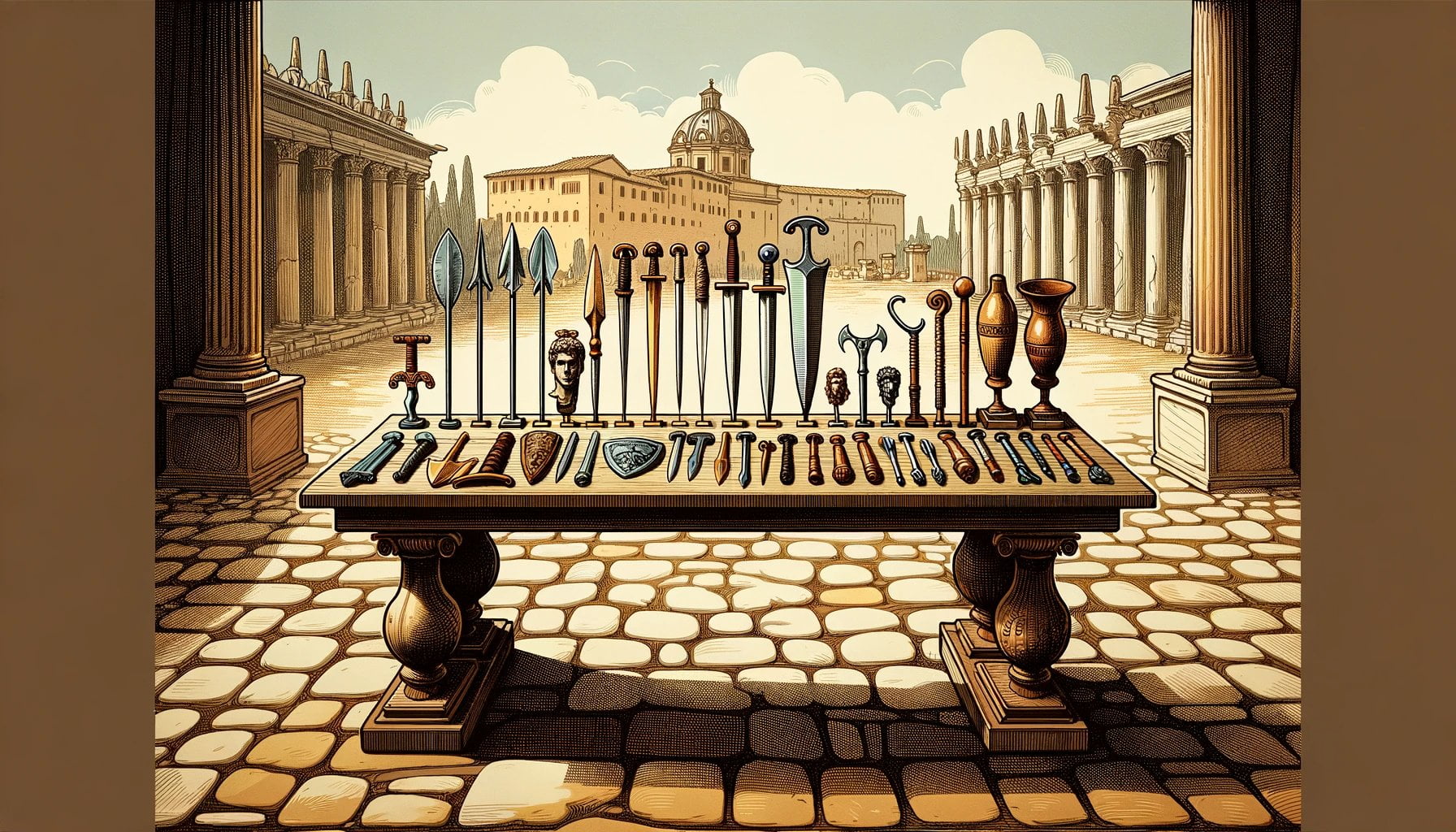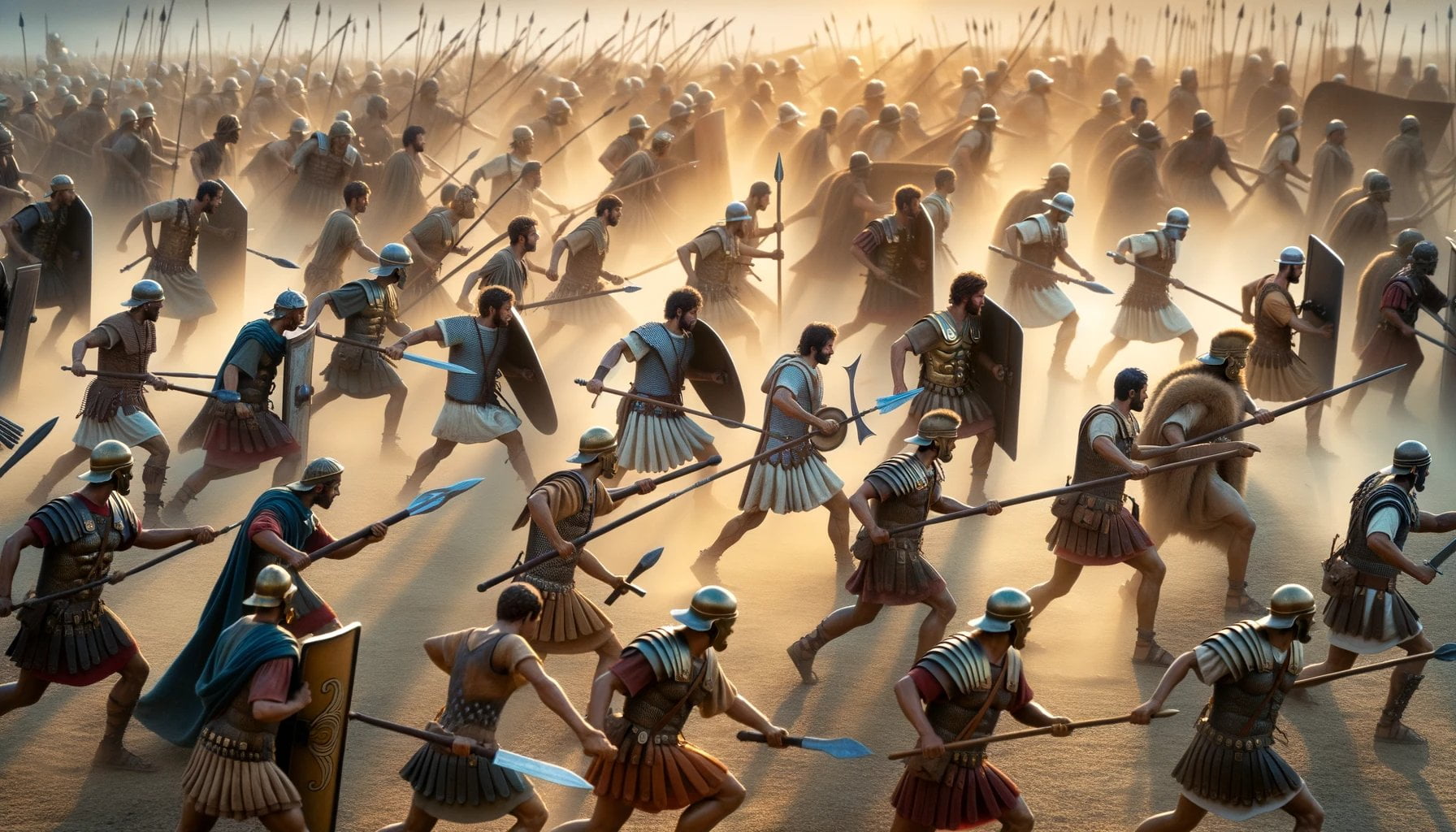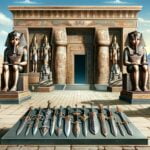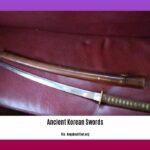Step into the fascinating world of ancient Rome’s weapons with our in-depth analysis of Rome’s formidable arsenal. As we delve into the rich history and impressive military might of the Roman Empire, we will uncover the secrets behind their ancient weaponry. From the legendary gladius sword to the feared pilum javelins, we will explore the designs, functionalities, and significant impact of these weapons on the empire’s success. Join us on this captivating journey through time and discover the awe-inspiring weaponry that shaped the fate of ancient Rome.

Key Takeaways:
- Ancient Roman soldiers primarily used spears, swords, and shields in battle. They relied on discipline and organization to defeat enemies on horseback armed with bows.
- In addition to spears and swords, Romans also utilized weapons such as slings, sling shots, bows, catapults, and ramming naval ships.
- The main types of swords used by the Roman army were the gladius and the spatha. The gladius, a short two-sided sword, was the primary weapon of the Ancient Roman legions.
- Roman soldiers typically wore body armor, helmets, and shields for protection in battle. As the Roman Empire developed, the complete Roman army was outfitted with armor, unlike the early days of the Roman kingdom where soldiers only used greaves.
Ancient Rome Weapons
When we think of Ancient Rome, we often imagine powerful legions marching across vast territories, conquering lands, and establishing one of the greatest empires in history. But what were the weapons that helped these Roman soldiers achieve such remarkable feats? Let’s delve into the incredible arsenal of Ancient Rome and explore the formidable weapons that played a pivotal role in the empire’s success.
Spears and Swords: The Backbone of Roman Warfare
Ancient Roman soldiers relied on discipline, superior organization, and an array of weapons to achieve victory in the battlefield. The two primary weapons used by Roman soldiers were spears and swords[^1^][^2^].
Spears were essential for throwing at close range and were often used to weaken enemy forces before engaging in close combat[^1^]. Roman spears, known as pilum javelins, were designed to stick into shields and make them unusable for the enemy. This tactic effectively disrupted enemy formations and created chaos on the battlefield[^2^].
Swords, particularly the gladius and the spatha, were the main weapons used by Roman foot soldiers[^2^][^5^]. The gladius, a short two-sided sword, was the primary weapon during the late Roman Republic and much of the Roman Empire. Its design allowed for quick and precise stabbing and slashing movements, making it deadly in close-quarters combat[^2^]. On the other hand, the spatha was a longer sword primarily used by cavalry and auxiliaries.
The Versatility of Ancient Roman Weapons
Beyond spears and swords, the Ancient Romans utilized a variety of weapons to gain an advantage on the battlefield. These included weapons such as slings, sling shots, bows, catapults, and even ramming naval ships[^1^].
Slings and sling shots were commonly used by Roman soldiers, providing them with a long-range attack option. These projectile weapons could hurl various types of ammunition, such as stones or lead bullets, at high speeds towards their foes[^1^]. The accuracy and power of slings made them effective weapons in both open field battles and sieges.
Bows had an essential role in Roman warfare, but they were more commonly used by enemies of Rome, such as the Parthians or the Germanic tribes[^1^]. Nevertheless, the Romans did employ archers in their armies, especially during later periods of the empire.
Catapults, which were capable of launching large projectiles over long distances, provided the Romans with a devastating long-range attack capability. These massive siege engines were instrumental in capturing fortified cities and breaking enemy defenses[^1^]. From the famous onsagers to the smaller ballistae, the Romans used catapults in various sizes and designs.
Protecting Themselves: Roman Armor
To ensure their soldiers’ protection, the Romans also developed advanced armor[^8^]. Roman soldiers were usually equipped with body armor, helmets, and shields, forming a formidable barrier against enemy attacks.
During the early days of the Roman kingdom, soldiers primarily wore greaves as leg protection, and full body armor was not the norm. However, as the Roman Empire expanded and evolved, the complete Roman army was outfitted with increasingly sophisticated armor[^8^].
The Roman legionnaires’ fierce reputation was in part due to their highly effective equipment, including the famous lorica segmentata (segmented armor). With its layered design, the segmentata provided excellent protection without sacrificing mobility[^8^]. Roman helmets were also well-crafted, offering head protection while still allowing soldiers the necessary visibility and breathability.
Unveiling the Ancient Rome Weapons: An Enduring Legacy
The weapons of Ancient Rome showcased the empire’s military excellence and the meticulous engineering behind their success. From the versatile swords to the lethal pilum javelins, these weapons were the tools that shaped the destiny of nations. The Romans’ meticulous craftsmanship, combined with their profound understanding of battle tactics, cemented their place in history as one of the greatest military forces of all time. So, let us continue to explore the intricate details and incredible stories of Ancient Rome’s weapons, ensuring their legacy lives on for centuries to come.
In ancient Rome, there were many important people who shaped the course of history. If you are curious to learn more about these influential figures, click here to explore a comprehensive list of important people in ancient Rome.
Did you know that there are fascinating theories about the black origins of ancient Rome? Click here to delve into a thought-provoking exploration of this intriguing topic.
If you have an interest in weaponry, you’ll be intrigued to discover the secrets of the ancient Rome dagger. Click here to unlock the mysteries behind this formidable weapon.
Step back in time to witness the daily life in ancient Rome by exploring the insulae, the fascinating apartment buildings of the city. Click here to immerse yourself in the vibrant culture and architecture of this ancient metropolis.
Remember to click on the hyperlinked keywords to navigate to the respective URLs and delve deeper into these captivating aspects of ancient Rome.
Projectile Weapons: Pilum and Ballista
The ancient Roman Empire was renowned for its formidable arsenal of weapons that played a crucial role in their military success. Among these weapons, the pilum and ballista were two projectile weapons that stood out for their effectiveness and impact on the battlefield. Let’s delve into a detailed analysis of these remarkable weapons and understand their significance in ancient Rome’s warfare.
The Pilum: An Armor-Piercing Javelin
The pilum was a javelin commonly used by the Roman army in ancient times. It consisted of a long wooden shaft, approximately 2 meters in length, with an iron shank attached to it. The shank, about 7mm in diameter and 600mm long, had a pyramidal head. The head was either connected to the wooden shaft by a socket or a flat tang.
With a total weight between 1 and 2.5 kg, the pilum was designed for armor-piercing capabilities. Its pyramidal tip, coupled with its weight, made it a deadly projectile meant to penetrate through layers of armor. The shank, sometimes made of softer iron, would bend upon impact, rendering the weapon useless to the enemy or forcing them to carry a shield burdened by its weight.
Legionaries of the late Republic and early Empire commonly carried two pila, with one occasionally being lighter than the other. The standard tactic involved throwing one pilum to disrupt the enemy formation and then engaging in close combat with the second pilum or a gladius, the Roman sword.
Through experimental archaeology, experts have discovered that the design of the pilum evolved to enhance its armor-piercing capabilities. The pyramidal head would punch a small hole through the enemy’s armor, making it easier for the pilum to penetrate and cause damage.
Overall, the pilum proved to be an effective weapon in the Roman army’s arsenal. Its armor-piercing capabilities and ability to disrupt enemy formations made it a formidable force on the battlefield.
The Ballista: A Powerful Siege Engine
In addition to the pilum, the Romans also utilized another impressive projectile weapon known as the ballista. The ballista was essentially a large crossbow-like weapon used for long-range attacks. It was primarily employed during sieges to hurl massive projectiles at fortifications or enemy troops.
The ballista had a torsion power system that generated immense force. It consisted of two arms attached to torsion springs, which stored energy when the arms were flexed. When released, the arms propelled the projectile forward with incredible speed and accuracy.
The projectiles launched by the ballista, known as bolts, were often made of heavy wood with iron heads. These bolts could penetrate enemy defenses, wreaking havoc on fortifications and causing significant damage to troops.
The ballista provided the Roman army with a devastating long-range attack capability, allowing them to weaken and breach enemy defenses before launching a full-scale assault. Its precision and power made it a formidable weapon in sieges and set the stage for Roman military victories.
Key Takeaways:
- The pilum was a deadly javelin commonly used by the Roman army, designed for armor-piercing capabilities. Its pyramidal tip and weight allowed it to penetrate through layers of armor.
- Roman soldiers carried two pila, using them strategically to disrupt enemy formations and engage in close combat.
- The ballista, a powerful siege engine, was employed during sieges to launch accurate and devastating long-range attacks.
- The torsion-based power system of the ballista generated immense force, propelling heavy bolts with great speed and accuracy.
- Both the pilum and ballista played significant roles in Roman warfare, showcasing the empire’s military excellence and tactical prowess.
Sources:
Defensive Weapons: Lorica Segmentata and Scutum
The lorica segmentata, or lorica lamminata, was a type of personal armor utilized by Roman soldiers. Made of metal strips, these circular bands were fastened to internal leather straps [^1^]. While commonly associated with the Romans, the lorica segmentata was also used by other civilizations before them. Similar sets of armor have been discovered in archaeological sites dating back to the 4th century BC [^7^]. The exact adoption time by the Romans remains uncertain, but it is believed to have been introduced after significant events like Crassus’ defeat at Carrhae in 53 BC or the Revolt of Julius Sacrovir and Julius Florus in 21 AD [^7^].
Constructed with overlapping ferrous plates riveted to leather straps, the lorica segmentata offered both flexibility and protection. The plates consisted of soft iron on the inside and rolled mild steel on the outside [^10^]. Unfortunately, the specific type of animal used for the leather and the tanning process employed remain unknown [^10^].
The name “lorica segmentata” was not given by the Romans themselves, but rather by later scholars in the 16th century. Some theorists suggest that the Romans referred to the armor as lorica lamminata due to their use of the term “lamina” when describing metal sheets [^1^].
Although the lorica segmentata is widely depicted as the armor worn by Roman legionaries, the more common type of armor used by soldiers was the lorica hamata, a chain mail style. Roman monuments, including the Arch of Constantine, showcase legionaries clad in the lorica segmentata. Some argue that portions of the Arch of Constantine were even repurposed from an earlier monument by Marcus Aurelius [^7^].
Over time, the lorica segmentata evolved, with different types of armor being used during various periods. The Dangstetten-Kalkriese-Vindonissa type was worn from 9 BC to 43 AD, followed by the Corbridge-Carnuntum type from 69 to 100, and the Newstead type from 164 to 180 [^7^]. There may have also been a fourth type of armor, which featured segmented armor joined to scale shoulder defenses, yet evidence supporting its existence is limited [^7^].
Key Takeaways:
– The lorica segmentata was a type of metal armor used by Roman soldiers.
– Its construction involved overlapping iron plates riveted to leather straps.
– The lorica segmentata’s exact Roman name remains unknown, but it is commonly referred to as such by scholars.
– While associated with the Romans, this type of armor was also used by other civilizations before them.
– The lorica segmentata evolved over time, with different variations being used during different periods.
Sources:
[^1^]: Wikipedia – Lorica segmentata
[^7^]: D’Amato, Raffaele; Sumner, Graham (2009). Arms And Armour of the Imperial Roman Soldier. Barnsley: Frontline Books. ISBN
Siege Weapons: Onagers and Battering Rams
Ancient Rome was known for its impressive military might and strategic warfare tactics. Among the various weapons utilized by the Roman Empire, siege weapons played a crucial role in sieges and conquests. In this article, we will delve into two formidable siege weapons employed by the Romans: onagers and battering rams. Let’s explore their designs, functionalities, and the significant impact they had on the success of the Roman Empire.
Onagers: The Powerful Catapults of Ancient Rome
What were onagers?
Onagers were massive catapults used by the Romans to launch projectiles at enemy fortifications. These powerful machines derived their name from the way they kicked backwards when firing, reminiscent of the wild donkey after which they were named.
How did onagers work?
An onager consisted of a wooden frame mounted on wheels, with a long arm attached to it. A torsion power system, often made of twisted animal sinew or hair, provided the force required to launch the projectiles. The arm of the onager was pulled back, applying tension to the twisted ropes, before being released to hurl the projectile towards the target.
What was the range and impact of onagers?
One of the remarkable features of onagers was their long-range capabilities. These siege weapons allowed the Romans to rain havoc on their enemies from a distance of up to 500 yards. The projectiles launched by onagers, such as stones or even flaming bundles, could penetrate enemy defenses, inflict casualties, and cause considerable damage to fortifications.
The Revolutionary Impact on Roman Siege Warfare
The introduction of onagers revolutionized Roman siege warfare. By enabling attacks from a safe distance, these catapults reduced the likelihood of Roman soldiers being exposed to enemy fire and allowed them to weaken fortifications before launching direct assaults. This tactical advantage played a significant role in the Romans’ ability to conquer and control vast territories.
Battering Rams: Breaking Down the Barriers
What were battering rams?
Battering rams were another crucial siege weapon employed by the Romans. These heavy and massive devices were used to break down an enemy’s walls by smashing open the gates of a city or fortress.
How did battering rams work?
A typical battering ram consisted of a large wooden beam, thickened and reinforced at one end with metal. It was attached to a wheeled carriage or suspended from a movable frame, allowing it to be easily maneuvered. Roman soldiers, often working in teams, would push or swing the battering ram against the gates or walls of the enemy stronghold, using its sheer force to breach the defenses.
Advantages and Impact of Battering Rams
Battering rams provided several advantages in siege warfare. By directly targeting gates and walls, these siege weapons could create openings, allowing Roman soldiers to storm inside and conquer enemy cities. The use of battering rams also provided cover fire for troops, distracting and diverting the attention of defenders. Their effectiveness in breaking down barriers made them an essential tool in the Roman army’s arsenal.
Key Takeaways:
- Onagers were powerful catapults that launched projectiles at enemy fortifications and had long-range capabilities.
- The introduction of onagers revolutionized Roman siege warfare, allowing for safe and effective long-range attacks.
- Battering rams were heavy devices used to break down enemy walls and gates.
- Battering rams provided a direct means of breaching enemy defenses and were used to storm conquered cities.
- Both onagers and battering rams played integral roles in the Roman army’s success during sieges.
Sources:
– History Skills – How did the Romans besiege and capture cities?
– History on the Net – Engines of Destruction: Roman Advancement of Siege Warfare

FAQ
Q1: What were the main weapons used by ancient Roman soldiers?
A1: Ancient Roman soldiers primarily used spears and swords in battle. They relied on discipline and superior organization to defeat enemies on horseback armed with bows. Roman foot soldiers fought with a shield, a spear for throwing at close range, and a short sword for stabbing and slashing. In addition to spears and swords, ancient Romans also used other weapons such as slings, sling shots, and bows themselves. They also had catapults for long-range attacks and ramming naval ships.
Q2: What types of swords did the Roman army use?
A2: The two main types of swords used by the Roman army were the gladius and the spatha. The gladius was a short, two-sided sword used during the late Roman Republic and much of the Roman Empire. It was the primary weapon of the Ancient Roman legions.
Q3: What was the purpose of the Roman pilum?
A3: The pilum was a javelin commonly used by the Roman army in ancient times. It was designed to be an armor-piercing weapon and disrupt enemy formations. Roman soldiers often carried two pila, using one to throw at the enemy before engaging in close combat with the second pilum or a gladius.
Q4: How was the lorica segmentata constructed?
A4: The lorica segmentata was a type of personal armor used by Roman soldiers. It consisted of metal strips fashioned into circular bands, which were then fastened to internal leather straps. The plates were made of soft iron on the inside and rolled mild steel on the outside, providing both flexibility and protection against damage.
Q5: What were some of the siege weapons used by the Romans?
A5: The Romans used various siege weapons, including the battering ram, siege tower, onager, and scorpio. The battering ram was used to break down an enemy’s walls, while the siege tower allowed Roman soldiers to attack from a higher position. The onager was a catapult that launched projectiles, and the scorpio was a type of artillery used for cover fire and damaging enemy defenses during sieges.
- China II Review: Delicious Food & Speedy Service - April 17, 2025
- Understand Virginia’s Flag: History & Debate - April 17, 2025
- Explore Long Island’s Map: Unique Regions & Insights - April 17, 2025
















